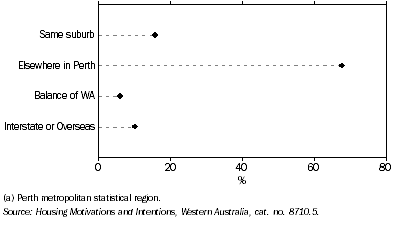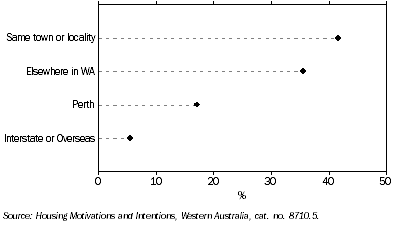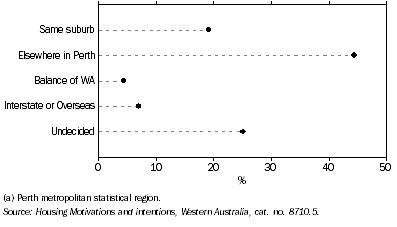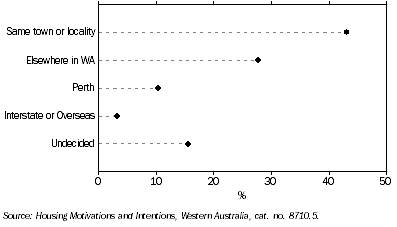Western Australians on the move - A housing perspective
INTRODUCTION
The 2005 ABS Survey of Housing Motivations and Intentions found that approximately two-thirds (944,600 persons) of all Western Australians aged 18 years and over had moved into their current dwelling less than ten years ago and one quarter (360,800) plan to move within the next three years.
Another survey conducted in 2003 by the Western Australian government confirmed that the Australian dream of living in a stand alone home in the suburbs was alive and well for the people of Perth, with around 80% attracted to this type of dwelling. Findings from the 2005 ABS survey indicate that the dream is now a reality, with 85% of all persons aged 18 years and over living in a separate house in Western Australia (most of which were fully owned or being purchased). This article uses data from these and other sources to show housing movements in Western Australia.
RECENT MOVERS
Recent movers are classed as those persons who have lived in their current dwelling for less than ten years. Of those recent movers living in the Perth Metropolitan area (699,000 persons), most (84%) had moved from elsewhere in Perth, and notably 16% had moved within the same suburb. As shown in the graph below, an additional 10% had moved from interstate or overseas and 6% from country Western Australia.
RECENT MOVERS IN PERTH(a), By location of previous dwelling - October 2005

Of those recent movers living in the Balance of Western Australia (233,600 persons), only 6% had previously lived interstate or overseas. More than three-quarters had previously lived in the Balance of Western Australia (42% in the same town or locality and 36% elsewhere in the Balance), while 17% had lived in Perth (see graph below).
RECENT MOVERS IN BALANCE OF WA, By location of previous dwelling - October 2005

RECENT MOVERS FROM INTERSTATE OR OVERSEAS
While most recent movers had moved within Western Australia (846,000 persons), 83,500 had previously lived interstate or overseas, accounting for 9% of all recent movers. A higher proportion (10%) of recent movers to Perth had moved from interstate or overseas (70,600 persons), compared to 6% to the Balance of Western Australia from interstate or overseas (12,900 persons).
The distribution of recent movers from interstate or overseas across the five Perth Metropolitan regions was 30% in North Metropolitan, 23% in South West Metropolitan and 22% in South East Metropolitan. The lowest proportions were in Central Metropolitan and East Metropolitan (12% each).
CHOICE OF CURRENT LOCATION AND DWELLING
Popular reasons for recent movers choosing their current location were quiet location (43%), to be close to family or friends (42%) and familiarity with the area (41%). The main reasons for recent movers choosing their current dwelling were appearance and layout (57%), the desire for a larger residence (57%), or for a smaller residence (45%) and the price range (45%).
FUTURE MOVERS
Future movers are classed as those persons who are intending to move within the next three years. About 48% of future movers have lived in their current dwelling for less than two years, with 54% of those intending to move expecting to do so within the next twelve months.
Almost two-thirds of future movers living in the Perth Metropolitan area (278,900 persons) intended to stay in Perth (19% in the same suburb and 44% elsewhere within Perth). Only 7% intended to move interstate or overseas and 4% elsewhere in Western Australia. About 25% were undecided about their future location (see graph below).
FUTURE MOVERS IN PERTH(a), By location of future dwelling - October 2005

Most future movers living in the Balance of Western Australia (360,800 persons) intended to stay outside of Perth (43% in the same town or locality and 28% elsewhere in the Balance), while 10% intended to move to Perth and 3% interstate or overseas. The remainder were undecided about their future location (16%) (see graph below).
FUTURE MOVERS IN BALANCE OF WA, By location of future dwelling - October 2005

Western Australia is currently experiencing a boom in house prices. The Real Estate Institute of Western Australia reports that it is getting harder for first home buyers to break into the market and that properties are being bought up by investors.
The ABS Survey of Housing Occupancy and Costs showed in the 10 year period from 1994 to 2004 there were increases in the proportion of households that had a mortgage on their homes (from 32% to 38%) and in the proportion that were renting privately (from 20% to 22%).
In 2005, there were 338,500 future movers intending to stay in Western Australia (including some who were undecided about the location of their future dwelling). Of these, 64% were intending to purchase their future dwelling. This included 92,300 future purchasers who were renting their current dwelling and intend to purchase their future dwelling.
CHOICE OF FUTURE LOCATION AND DWELLING
Popular reasons of future movers for their preferred location were familiarity with the area (55%), central location (49%), price range (49%), better lifestyle (48%) and access to facilities and services (48%). Popular reasons for their preferred dwelling were appearance and layout (70%), separate house (68%), better quality residence (53%) and low maintenance (51%). Larger blocks (34%) were preferred to smaller blocks (23%) and there was a similar preference for larger residences (45%) compared to smaller residences (19%).
The 2003 Western Australian government survey found that Perth residents prefer to live in low to medium population density areas on average (500 - 800m²) or larger than average (over 800m²) sized blocks. The ABS found that 72% of future movers of Western Australia are looking to move to a separate house with three to four bedrooms.
Those survey respondents also indicated that they wanted to see a trend in Perth where environmental protection was of equal importance as economic growth (93%) and that there should be incentives for people and companies involved in environmentally friendly building developments (91%). In contrast, the ABS survey found that the reason of ‘energy efficiency’ (33%) for choosing their future dwelling was not as popular as other responses.
THE BABY BOOMERS
By 2025, 26% of Western Australia's population is projected to be aged 60 years and over. By then, the entire baby boomer generation (those born between 1946 and 1965 inclusive) will be part of this age group. In general, people downsize their homes as they age, trading separate houses for other types of dwellings such as duplexes and villas. At the time of the 2001 Census, people aged 60 years and over made up 15% of the population with 74% living in separate houses. This is 12 percentage points less than for the remaining younger population of whom 86% lived in separate houses.
As the baby boomer generation reach their retirement years it could be expected that demand for separate houses will decline. Anecdotally, however, it would appear that while Western Australia's baby boomers may be 'downsizing' their gardens as they age, they are not downsizing their homes. The ABS found that 79,700 persons were living in a dwelling where at least one usual resident was aged 55 years and over and intending to move within the next three years. Most of these (58%) were intending to move to a separate house. The option of a retirement village or group housing complex (where residency is restricted to people aged 55 and over) was not a popular choice with the vast majority of these persons (85%), indicating they did not intend to move to this type of complex.
In general, older people are more likely to own their home outright. In seniors’ households (where at least one usual resident was aged 60 years or over), 68% were living in a dwelling that was fully owned compared to only 23% of persons living in fully owned dwellings in non-seniors households. Despite the ageing population, the ABS Survey of Housing Occupancy and Costs showed a decrease in the proportion of households that owned their dwellings outright over the 10 years from 1994 to 2004 (declining from 38% to 31%).
SUMMARY
These results indicate that the Australian dream of a house in the suburbs will continue to be a driving force behind many people’s housing preferences in the near future, regardless of age, and despite inner city redevelopment schemes and lifestyle village options. This will further impact on Western Australia's existing housing pressures as development continues.
REFERENCES
ABS PUBLICATIONS
Australian Bureau of Statistics 2006a, Housing Motivations and Intentions, Western Australia, October 2005, cat. no. 8710.5, ABS, Canberra.
Australian Bureau of Statistics 2006b, Housing Occupancy and Costs, Australia, 2003-04, cat. no. 4130.0.55.001, ABS, Canberra.
Australian Bureau of Statistics 2006c, Population Projections, Australia, 2004 to 2101, cat. no. 3222.0, ABS, Canberra.
Australian Bureau of Statistics 2002, Census of Population and Housing, 2001, Unpublished data, ABS, Canberra.
NON-ABS PUBLICATIONS
Real Estate Institute of Western Australia 2006, www.reiwa.com.au
Government of Western Australia 2004, Network City - community planning strategy for Perth and Peel, Department for Planning and Infrastructure, Western Australia, Perth.
 Print Page
Print Page
 Print All
Print All